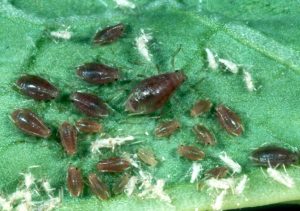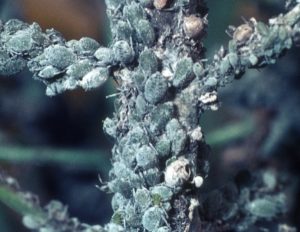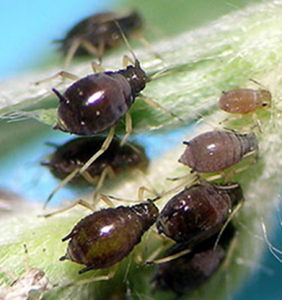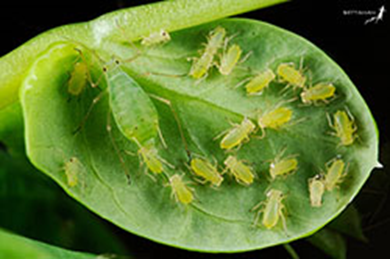- What are aphids
- Biology of aphids and PVY
- Management of aphids
- Important Vectors of PVY in potato – Colonizers and Non-colonizers
- PVY Vector Photo Gallery
What are aphids?
- Aphids are small, soft-bodied insects that feed on plants with their piercing-sucking mouthparts (stylets)
- Aphids can transmit viruses between plants when they “taste test” or feed
- PVY is acquired and transmitted by aphids within seconds
- PVY is transmitted by aphid species that love (colonizing) and hate (non-colonizing) potato
- Aphids can carry PVY long distances on wind currents
- Aphid life cycles promote movement of PVY
- Control of aphid vectors is not usually an effective PVY management strategy
Biology of aphids and PVY
Aphids are small, soft-bodied insects that feed on plants with their piercing-sucking mouthparts (stylets). Aphids randomly land on plants in search of a suitable host. They will first “taste test” the plant by making several brief probes into cells near the surface of the leaf. If the plant is determined to be a suitable host, the aphid will subsequently feed in the vascular tissue (phloem) that circulates carbohydrates throughout a plant. Phloem-feeding aphids excrete a sugary waste called ‘honeydew’ that can serve as a substrate for a black fungal growth. This is not a plant pathogenic fungus, but heavy aphid infestations delay plant development and impair plant health—causing leaf curling, stunting, or wilting.
Aphids can transmit plant viruses between plants when they taste test or feed. Transmission of virus is classified as non-persistent, semi-persistent or persistent depending on how long it takes for the aphid to acquire and inoculate the virus and how long the virus persists within the aphid.
PVY is acquired and transmitted by aphids within seconds. PVY adheres quickly to the aphid’s stylet during their “taste test” probes. Within seconds the aphid acquires virus and it can subsequently inoculate a plant within seconds when it taste tests another plant. Frequent taste tests will quickly cleanse the stylet of virus, but a single aphid can inoculate multiple plants as it moves through a potato field in search of a new host to settle on. For this type of transmission the plant does not have to be a preferred host of the aphid for transmission to occur, the plant only has to be a host of the virus. This is the most important factor when considering the efficacy of insecticides as a virus management strategy. Also consider that aphids can fly long distances on wind currents and will carry the virus with them. When they drop out of the air currents and land on random plants they can quickly inoculate the virus if they happen to land on a plant that is a host of the virus. Virus inoculation by immigrant aphids will not be stopped by insecticide treatment of the plants the aphids are landing on regardless whether potato is a preferred host of the aphid.
PVY is transmitted by aphid species that love (colonizing) and hate (non-colonizing) potato. Colonizing aphids will feed and reproduce on potato as a preferred host. The immigrating aphid if carrying PVY will inoculate the plant during its taste testing and then subsequently feed long term in the phloem while it deposits offspring on the plant. The non-winged offspring are likely to acquire the virus and then can spread it as they walk to adjacent plants. If the aphid colonies gets too crowded, winged forms of offspring will be generated and those will fly to other plants or longer distance to other fields taking the virus with them. Colonizing aphids usually feed on new, succulent shoot tips or young leaves, often on the underside of the leaf. Non-colonizing winged aphids are those species that do not feed on potato, but may taste test several plants as they move through the field, acquiring and inoculating virus as they go. While colonizing aphids are generally more efficient vectors of PVY than non-colonizers, the sheer numbers of migrating non-colorizing aphids can pose a significant threat by introducing and moving virus into and within a field. The standard use of systemic insecticides on most potatoes has minimized the populations of colonizing aphids so most of the PVY spread occurring in the US potato crop is due to transient noncolonizing aphids. Soybean aphid and grain aphids (e.g. Corn-leaf aphid, Bird cherry-oat aphid, English grain aphid) are the prominent PVY vectors in the US.
Aphids can carry PVY long distances on wind currents. Aphids that vector PVY have both winged (alate) and wing-less (apterous) forms. Movement of winged aphids can be promoted in agricultural settings when cutting fields for hay, cultivating, spraying, or during harvest activities.
Aphid life cycles promote the movement of PVY. Every time winged aphids migrate they probe along the way until they find a suitable host plant. This happens in spring and fall and periodically throughout the summer. In temperate regions, many aphids produce eggs to survive winter on a primary plant host. In spring, eggs hatch and winged aphids migrate to secondary, summer host plants. Females will give birth to live young throughout the year via parthenogenesis (asexual reproduction), often producing several generations. One adult female can birth 20 to 50 nymphs that can mature in 14 to 21 days under summer conditions. While most offspring do not have wings and will move only to adjacent plants, winged forms will be produced when the colony gets crowded or in response to poor host plant quality. These winged aphids will migrate to other plants. Migration in mid-summer (e.g. grain aphids) or late summer (e.g. soybean and pea aphids) when aphids take flight to find overwintering host plants to lay eggs. These are the aphids commonly moving through potato fields and spreading PVY.
Management of Aphids
For more detailed information see PVY Management section on aphids.
Aphid feeding can be detrimental to plant health, especially if colonies are allowed to develop unchecked. Insecticides are effective against colonizing aphids and should be applied if scouting indicates that aphid populations are above threshold levels. Controlling colonizing aphids will also help prevent within field spread of virus, by minimizing the number of aphids crawling between plants. As mentioned above, the insecticides will have no effect on preventing PVY inoculation of plants by immigrating winged aphids (colonizing or non-colonizing) carrying virus and minimal effect on immigrating winged non-colonizing aphids acquiring and spreading virus among the few plants each of them will taste test as they sample and move through the potato field. Insecticides with anti-feeding properties will generally not stop feeding in time to prevent the initial transmission of PVY, but they may have some effect on preventing subsequent taste testing. Oils may also have some affect on the initial and subsequent virus transmission and movement of aphids if the leaf surfaces are evenly protected. Conversely, some insecticides will cause an increased movement of aphids as they immigrate into a potato field and actually result in more plants being inoculated before the aphid is killed or moves on.
Important Vectors of PVY in Potato – Colonizers and Non-Colonizers
For more aphid images, visit the PVY Vector Photo Gallery
Colonizers of potato:

Buckthorn aphid (Aphis nasturtii)
Description: Small-sized insects. Body color of apterous yellow to greenish with dark apices siphunculi, without dorsal patch.
Distribution: Worldwide, except Australasia.
Host biology: It is highly polyphagous and feeds on herbaceous plants that belong to 28 different families in summer, and overwinters as an egg on buckthorn, Rhamnus cathartica.
Photo credit: David Voegtlin, University of Illinois

Green peach aphid (Myzus persicae)
This is perhaps the most efficient vector of PVY in potato.
Description: Body color varies from yellow to all shades of green, to pink, red, or black with a dorsal black patch at the base of abdomen, black thorax, pale-colored on ventral side of abdomen. Cornicles are medium length and slightly swollen with darkened tips.
Distribution: Worldwide, present in all areas of North America.
Host biology: Able to feed on many plant species. Exhibits host alternation, overwintering on woody perennial peach or plum (Prunus spp.) and summering on hundreds of plant species from across 40 plant families, including many herbaceous annuals. The green peach aphid has multiple biotypes that exhibit host preference and some have insecticide resistance.
Photo credit: David Voegtlin, University of Illinois

Potato aphid (Macrosiphum euphorbiae)
Description: Large insects with pear-shaped bodies and distinct red eyes. Body color varies from solid pink to green and pink mottled to light green. Long slender cornicles are often the color of the insect body. Nymphs are elongated and have a dark dorsal stripe and a light covering of white-gray wax making them paler than adults.
Distribution: Native of North America, worldwide except the India subcontinent.
Host biology: The potato aphid attacks over 200 plant species including vegetable and ornamental crops, as well as weeds. It overwinters as eggs on cultivated and wild rose (Rosa spp., Family Rosaceae).
Photo credit: David Voegtlin, University of Illinois
Non-colonizers of potato:

Bird cherry-oat aphid (Rhopalosiphum padi)
Description: Body color ranges from orange-green to olive-green to dark green, sometimes greenish-black. Wingless forms often with reddish-orange patch near the base of cornicles, rounded bulb-like body shape, antennae more than half the length of the body. Cornicles short, dark, swollen and tapered.
Distribution: Worldwide, throughout the United States.
Host biology: Host alternation, overwinters on woody perennials bird cherry (Padus racemosa) or plum (Prunus spp.), summer hosts mainly in Family Poaceae, especially maize, barley, oats, millet, and wheat. Heavy colonization occurs on winter wheat in early spring and late fall.
Photo credit: David Voegtlin, University of Illinois

Cabbage aphid or mealy cabbage aphid (Brevicoryne brassicae)
Description: Small sized insects. Apterous grayish green or dull mid-green with dark head. Dorsum abdomen with transversal markings and densely covered with grayish white mealy wax. Both morphs have short siphunculi, not longer than cauda, which is triangular.
Distribution: World-wide, throughout the United States.
Host biology: No host alternation. On many species of Brassicaceae, commonly found on Brassica oleraceae.
Photo credit: David Voegtlin, University of Illinois.
(No photo available)
Chenopodium aphid (Hayhurtia atriplicis)
Description: Small to medium-sized insects. Apterous green, covered with white wax powder. Dorsum abdomen of apterous without transversal markings. Only winged females with small transversal markings. Both morphs with short siphunculi, and finger-shaped cauda.
Distribution: World-wide, throughout the United States.
Host biology: No host alternation. Living inside pod-like yellowish pseudogalls forming of rolling leaves upawards usually on Atriplex spp. and Chenopodium spp. (Chenopodiaceae).

Corn leaf aphid (Rhopalosiphum maidis)
Description: Small insects with rectangular-shaped body, bluish-green to dark olive with a purplish patch near the base of cornicles. Short antennae and prominent black cornicles. Can be confused with R. padi, the bird cherry-oat aphid.
Distribution: Worldwide, throughout the United States.
Host biology: No host alternation, feeding primarily on grasses, preferring sorghum as a host but also corn, barley, millet, sudan grass, and other cereals. Infestations occur in late summer (August, September).
Photo credit: David Voegtlin, University of Illinois

Cowpea aphid (Aphis craccivora)
Description: A relatively small aphid. The adult is usually shiny black while the nymph is slate gray, often dull not shiny. The appendages are whitish, antennae darkening towards the tips and legs with dark “feet”.
Distribution: Worldwide, including North America.
Host biology: Polyphagous, though prefers members of Legume Family (Fabaceae). Cowpea aphid secretes a toxin while feeding and, when present in high numbers, can cause wilting, discoloration, stunting and death of the plant. Photo credit: © Andrew Jensen, http://www.eol.org/pages/588003, Creative Commons.

English grain aphid (Sitobion avenae)
Description: Body color yellow-green to reddish brown with long black legs and black cornicles, giving it a spider-like appearance. This medium-sized aphid with black antennae and black leg joints.
Distribution: Worldwide, all areas of North America with preference to cool, temperate climate zones.
Host biology: Host alternation. Overwinters on winter cereals and cereal weed species. In summer, occurs primarily on cereals including maize, wheat, and rice. Can develop on many cultivated or wild species of Family Poaceae, in addition to some species in the Families Juncaeae and Cyperaceae. Usually appears later in the season than other cereal aphids (late August, September).

Greenbug (Schizaphis graminum)
Description: Yellow-green, pear-shaped body, with a dark green stripe down the abdomen. The uniformly dark antennae extend more than half as long as the body. Tips of the cornicles and legs are almost black.
Distribution: Found in Central and South America, Europe, Africa, the Middle East and Asia, widespread throughout the United States.
Host biology: This species does not alternate between overwintering and summer hosts. Important agricultural hosts include: sorghum, wheat, barley, corn, millet, oats, rice, and rye. Lawns may harbor greenbug infestations. Eggs are laid into leaf sheaths of winter cereals or other grasses (Family Poaceae). Greenbugs inject toxin into plant hosts while feeding, killing plant cells near the feeding area. They possess a bacterial endosymbiont (Buchnera aphidicola) important for insect amino acid metabolism. Nine biotypes differ in host preference.
Photo credit: David Voegtlin, University of Illinois
(No photo available)
Leaf-curling plum aphid (Brachycaudus helichrysi)
Description: Small sized insects. Body color of the apterous or wingless depends of the host plant. On primary host yellow, green and brown. Shiny and slight waxing. On the secondary plant yellow, green, whiteish and pinkish. Dorsum abdomen of apterous has transversal markings, and winged famales with dorsal patch. Both morphs have short siphunculi, and short and blunt cauda. Antennae shorter than body length.
Distribution: World-wide, throughout the United States.
Host biology: Host alternation, overwinter as eggs on Prunus spp., with summer secondary hosts on stems and flowerheads of mainly Asteraceae (e.g., Achillea, Aster, Bidens, Chrysathemum, Helianthus, Senecio), and Anchusa, Cynoglossum, Symphytum, Rumex, Trifolium and Veronica.

Pea aphid (Acyrthosiphon pisum)
Description: Large, long-legged insect, body color a light to deep green with reddish eyes and long, slender cornicles.
Distribution: Throughout the United States and Canada, widespread throughout Europe, Asia, Africa, North and South America, Japan, and Russia.
Host biology: Overwintering and summer hosts are limited to members of Legume Family (Fabaceae). Important overwintering hosts include vetch (Vicia spp.) and crimson clover (Trifolium incarnatum) with alfalfa, Medicago sativa), cultivated and wild legumes as summer hosts. High infestations often occur during cool temperatures in early spring (May, June) and early fall (September, October). Aphids immediately fall off plants when disturbed.

Soybean aphid (Aphis glycines)
Description: Small, greenish-yellow insects with black cornicles.
Distribution: Native to Asia, established in the Midwest and Northeast United States, extending west to North Dakota and south to Mississippi.
Host biology: Exhibits host alternation, overwintering as eggs on woody perennial buckthorn (Rhamnus spp.) and in spring moving to soybean (Glycine max) as secondary summer host with feeding observed on other members of the Family Fabaceae.
Photo credit: David Voegtlin, University of Illinois.

Thistle aphid (Capitophorus elaeagni)
Description: Small to medium-sized insects. Body color is greenish white to yellowish green, with pale-colored appendages and a subrectangular solid black dorsal abdominal patch. Very long cornicles have dusky colored tips. Antennae as long as, or longer than, the body length.
Distribution: Native to Europe, found throughout temperate and warm temperate regions of the world, Australia, New Zealand, New Guinea, India.
Host biology: Host alternation, overwinters as eggs on Elaeagnus spp., with summer secondary hosts mainly thistles (Cirsium spp., Carduus spp., and Cynara spp.) in the Family Compositae. It may also feed on plants in the Family Polygonaceae. Thistle aphid colonies often cluster on the undersides of the lower leaves of summer host plants.

Wild crucifer aphid (Lipaphis pseudobrassicae)
Description: Small to medium-sized insects. Body color of apterous ranges from yellowish green, gray-green to olive-green, covered with white wax, and in humid conditions may become mealy dense.
Distribution: World-wide, throughout the United States
Host biology: No host alternation. On many species of Brassicaceae (e.g. Barbarea, Brassica, Capsella, Iberis, Raphanus, Rorippa)
Photo credit: David Voegtlin, University of Illinois.
For more aphid images, visit the PVY Vector Photo Gallery


